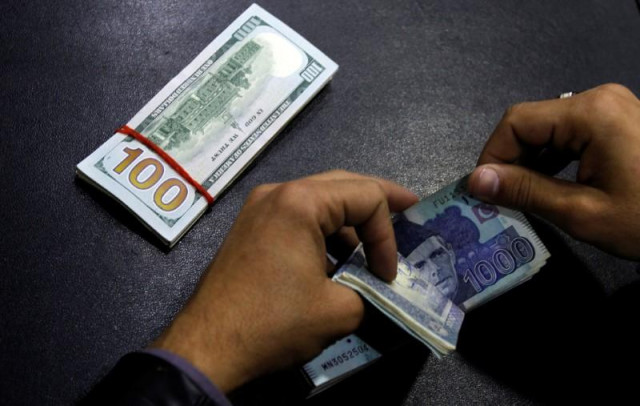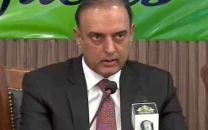Pakistan’s debt and liabilities surge to Rs31 trillion
Burden may grow in coming months due to rupee depreciation, interest rate hike

A currency trader counts Pakistani Rupee notes. PHOTO: REUTERS
The increase comes amid concerns over a rapid rise in the debt burden in coming months owing to currency depreciation and interest rate hike.
Statistics released by the State Bank of Pakistan (SBP) showed that by the end of first quarter of the current fiscal year, the country’s total debt and liabilities soared to Rs30.9 trillion. Within a span of just three months, there was an increase of Rs984 billion, or 3.3%, in the overall debt.
Of the Rs30.9 trillion, the gross public debt, which is the direct responsibility of the government, stood at Rs25.8 trillion. There was an increase of Rs839 billion in the gross public debt in three months, which was far higher than the overall budget deficit of Rs542 billion for the period.
One of the key reasons behind the higher debt was the increase in interest rate and depreciation of the rupee during July-September 2018.
A single rupee devaluation adds Rs97 billion to the public debt. Similarly, a 1% increase in interest rate increases the cost of debt servicing by roughly Rs180 billion. This ultimately increases borrowing requirements of the finance ministry.
The impact of currency depreciation and interest rate hike after September will be visible in next bulletin of the central bank. Since January, the central bank has let the currency weaken by one-third and has jacked up the interest rate by 4.25%. Total debt and liabilities also include the public sector enterprises’ (PSEs) debt, non-governmental external debt and inter-company external debt from direct investors abroad. Excluding liabilities, the country’s total debt swelled to Rs29.4 trillion.
The Ministry of Finance has not yet initiated the formal process to amend the Fiscal Responsibility and Debt Limitation Act 2005 to correct an anomaly created by the previous government. Former finance minister Ishaq Dar had twice amended the law to understate the debt. Because of the change in definition, the public debt, reported by the finance ministry, is Rs2 trillion lower than the actual debt burden.
Finance Minister Asad Umar has promised to address the issue.
The government’s domestic debt surged to Rs16.9 trillion with an addition of Rs507 billion in first three months of the current fiscal year.
The government’s external debt increased to a record Rs8.1 trillion by the end of September, a net addition of Rs327 billion in three months. The total external debt and liabilities surged to Rs12 trillion on the back of currency devaluation. The non-government external debt has also crossed Rs2 trillion.
The PSEs’ total debt grew to Rs1.5 trillion at the end of September, registering an increase of Rs80.7 billion or 6% in just three months. Their domestic debt soared from Rs1.07 trillion to Rs1.12 trillion. Their external debt also increased by Rs29 billion to Rs353.6 billion.
The Pakistan Tehreek-e-Insaf (PTI) government has promised to reform the loss-making enterprises. It has announced that it will set up Pakistan Sarmaya Company to separate these entities from the line ministries. The debt taken by Pakistan from the International Monetary Fund (IMF) remained unchanged at Rs741 billion in the three months due to currency devaluation. This was despite the fact that Pakistan returned nearly $133 million to the IMF during the first quarter.
Total liabilities, which are indirectly the responsibility of the finance ministry, slightly decreased to Rs1.42 trillion by the end of September. Domestic liabilities dropped from Rs820 billion to Rs809 billion. External liabilities decreased from Rs622 billion to Rs620 in the three months. Owing to a massive increase in the debt stock, the country’s interest payments have increased significantly.
Interest payments on debt stood at Rs362.8 billion at the end of first quarter. The government paid Rs298.3 billion in interest payments on domestic debt and Rs64.5 billion on external debt, which was quite a high figure. The external debt servicing in the first quarter of the last fiscal year was only Rs40 billion.
The depreciation of the currency has also significantly increased the cost of external debt servicing.

Published in The Express Tribune, December 7th, 2018.
Like Business on Facebook, follow @TribuneBiz on Twitter to stay informed and join in the conversation.



















COMMENTS
Comments are moderated and generally will be posted if they are on-topic and not abusive.
For more information, please see our Comments FAQ